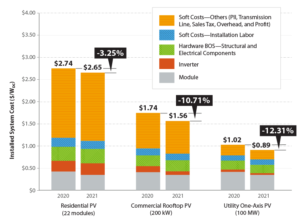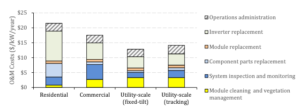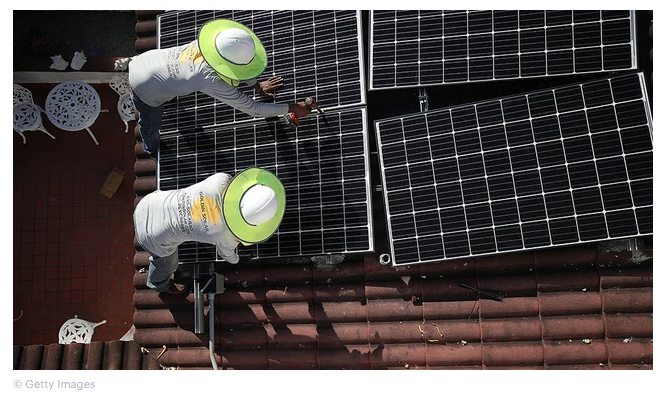On September 21, 2022, the New York Times published an essay by Gabriel Popkin titled “Are There Better Places to Put Large Solar Farms Than These Forests?” Popkin describes a recently approved 4,500-acre solar project in Virginia that will remove approximately 3,500 acres of forest and asks whether such projects could be sited instead on rooftops, parking lots, and other degraded land. This blog post provides some additional information and context to Popkin’s essay.
First, only a very small percentage of solar projects in the United States are currently being sited on forested lands. While Popkin correctly notes that approximately 50% of solar energy facilities, as measured by land area, are sited in deserts, the assertion that “more than four-fifths of the rest go on farmland, forestland or grasslands” requires additional context. Specifically, it is important to understand that solar is not being sited in equal quantities on these three types of land, as farmland hosts far more solar projects (33%) than either grassland (6%) or forests (4%). For comparison, nearly 3% of solar power is currently sited in urban areas.[1]
Second, while Popkin correctly notes that forests, like solar farms, offer climate-change benefits, the essay does not provide any information on the relative emissions benefits of forested land versus solar farms. To be clear, forests offer immense benefits that have nothing to do with carbon sequestration, including by serving as critical habitat for native flora and fauna, filtering drinking water, preventing erosion, and providing scenic and recreational benefits to millions of people. However, on the narrow but important issue of carbon dioxide emissions, an acre of solar panels appears to offset more emissions each year than an acre planted with trees can sequester.
In the United States, the emissions intensity of electricity produced by natural gas-fired power plants is about 1,071 pounds per megawatt-hour (MWh) on a lifecycle basis, whereas the emissions intensity of solar PV is about 95 pounds per MWh, a difference of 976 pounds per MWh. According to the Lawrence Berkeley National Laboratory, utility-scale solar power produces between 394 and 447 MWh per acre per year. Thus, when solar panels are installed to replace natural gas, an acre of solar panels saves approximately 385,000 to 436,000 pounds, or 175 to 198 metric tons, of carbon dioxide per year. By comparison, according to the EPA, the average acre of forest in the United States sequesters 0.84 metric tons of carbon dioxide per year. Thus, an acre of solar panels installed to replace natural gas reduces approximately 208 to 236 times more carbon dioxide per year than an acre of forest.
What about the carbon that is released when an acre of forest is removed? According to the EPA, the average acre of forest contains 81 metric tons of carbon, although the exact figure depends heavily on the species of trees in the forest. Approximately half of that amount is sequestered in the soil. Even if all 81 metric tons of carbon, comprising 297 metric tons of carbon dioxide, were released upon conversion to a solar farm, those emissions would be offset within 2 years of operation.
Third, Popkin suggests that siting solar projects on farmland may interfere with an “obvious an important use: growing food.” However, solar projects can coexist with and complement agriculture, including by improving pollinator habitat and allowing animals to graze between rows of panels. The Great Plains Institute has found, for example, that “utility-scale solar can be compatible with other forms of non-cultivated agriculture like pasture and grasslands.” In addition, recent research has shown that growing crops, such as tomatoes, in between rows of solar panels in hot, dry climates may increase yields by creating shade, which conserves water, increases humidity, and lowers temperatures. Likewise, the Michigan Department of Agriculture and Rural Development (MDARD) has determined that “the placement of structures for commercial solar energy generation . . . is consistent with farming operations,” provided that certain measures are taken to maintain the integrity of agricultural land at the site, including by planting pollinator habitat and conservation cover. In addition, the income that farmers can earn by leasing out parts of their land for renewable energy projects allows them to keep the rest of their land in production while insulating them against low harvest years.
Moreover, any discussion of a purported conflict between agriculture and energy production must also acknowledge that more than one-third of all corn grown in the United States is used not for food—or even to feed livestock—but for energy. In total, more than 30 million acres of farmland, covering an area roughly the size of Louisiana, are effectively used to grow corn for ethanol. While the process of refining corn into ethanol generates other feedstocks, including some that are used for animal feed, it is clear that this land is not being maximized for food production.
Importantly, converting the land currently used for growing corn ethanol to solar energy would greatly increase the amount of energy produced on that land. Indeed, an analysis from PV Magazine recently found that converting the land currently used for corn ethanol to solar power could meet all of the nation’s electricity needs. Likewise, a UK-based analysis from Carbon Brief found that “a hectare of solar panels delivers between 48 and 112 times more driving distance, when used to charge an electric vehicle, than that land could deliver if used to grow biofuels for cars.”
Based on my own calculations, an acre of solar panels produces roughly 40 times more energy than an acre devoted to growing corn for ethanol—and this is without taking into account the fact that electric vehicles use energy more efficiently than gas-powered cars:
- As noted above, solar power produces between 394 and 447 megawatt hours (MWh) per acre per year.
- According to the University of Nebraska-Lincoln, one acre of corn produces approximately 462 gallons of ethanol.[2]
- With a heat content of 76,300 BTU per gallon of ethanol, 462 gallons of ethanol contains 35,250,600 BTU.
- Applying a standard conversion factor of 3,412,000 BTU per MWh, one acre of corn produces a quantity of ethanol equivalent to 10.3 MWh.
- Thus, an acre of solar panels produces roughly 38 to 43 times more energy per acre than corn ethanol, even assuming a relatively high output per acre of corn.
Fourth, as Popkin correctly acknowledges, rooftops and parking lots are “generally more expensive to develop than forest or farmland.” However, Popkin does not explain how much more expensive it is to build solar on rooftops or parking lots. According to the National Renewable Energy Laboratory (NREL), the average cost per watt of installing rooftop solar projects is approximately 1.75-3 times as expensive as utility-scale solar. The average cost per watt of a utility-scale solar system is $0.89, compared to $1.56 for a commercial rooftop project and $2.65 for a residential rooftop project.
Figure 1: NREL Chart Comparing Installation Costs of Residential Solar, Commercial Rooftop Solar, and Utility-Scale Solar
Constructing solar canopies over parking lots also appears to be more expensive than utility-scale solar. The industry publication PV Magazine has used $3 per watt as a back-of-the-envelope figure, while Energy Sage has estimated, based on data from its solar energy marketplace, that the average installation cost is $3.31 per watt. To provide one real-world example, the 12.3-megawatt (MW) solar canopy under construction at JFK International Airport will cost $56 million, or $4.55 per watt. While the construction costs of solar canopies may be offset in some cases by charging a premium for the shaded parking spots underneath, it will be more challenging to recoup such costs in places where parking is free. And these are just the installation costs; it is also more expensive to maintain small, widely dispersed units than one large system.
Figure 2: NREL Chart Comparing Operations and Maintenance Costs of Residential, Commercial, and Utility-Scale Solar
Ultimately, achieving net zero carbon dioxide emissions by the early 2050s to limit warming to 1.5 degrees Celsius will require siting an unprecedented number of renewable energy facilities in a very short time. At this time, siting solar projects on forested land remains relatively rare; in the rare instances when solar is sited on forested land, those projects appear to offset more emissions on a per-acre basis than trees can sequester; the 30 million acres of farmland that are currently being used to produce corn ethanol could produce much more energy as solar farms without harming food production; and utility-scale solar projects remain significantly cheaper to install and maintain than rooftop and parking lot solar projects.
Endnotes
[1] This information comes from the supplementary data of the Nature article that Popkin cites for national land use figures. Virginia, where the 4,500-acre project described in Popkin’s essay is located, appears to use more forestland than the national average due to several large outlier projects in forested areas.
[2] University of Nebraska-Lincoln’s estimate of 462 gallons of ethanol per acre appears to be at the high end. Others have found output closer to 317 gallons per acre.
*Updated on December 18, 2023 to reflect that the lifecycle emissions of solar PV are approximately 95 pounds per MWh and to clarify that ethanol co-products include animal feed.
Matthew Eisenson is a Senior Fellow at the Sabin Center for Climate Change Law, where he leads the Renewable Energy Legal Defense Initiative (RELDI).






